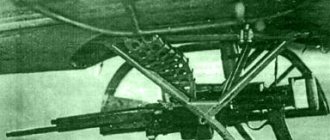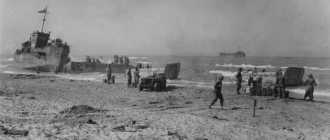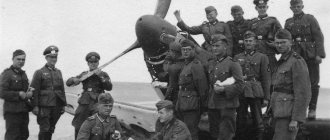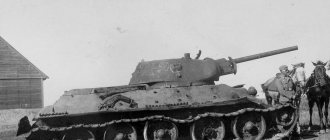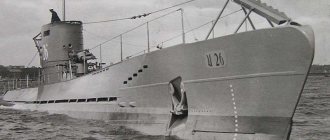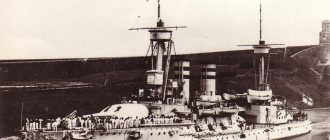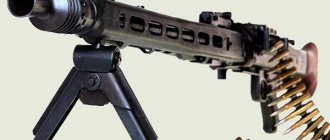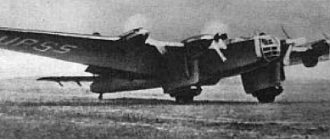Such unification simplified the supply and training of troops and ensured high tactical flexibility.
In 1930, the Reichswehr Armament Directorate issued a new tactical and technical specification for the construction of a single machine gun. The main requirements for “candidates” were: ease; the ability to use it as a light machine gun on a bipod and as an easel machine gun on a machine; belt feeding; rate of fire not lower than 600 rounds/min; air cooling; use of a standard 7.92x57 mm rifle-machine-gun cartridge; Possibility of installation on combat vehicles of all types, as well as in anti-aircraft machine gun installations.
The development of new weapons was led by Rheinmetall-Borsig. The development team was led by leading German gunsmith Louis Stange. Other companies also took part in the design of the machine gun, in particular, one of the main designers was Heinrich Vollmer, an employee of (Mauser Werke). The final version of the new model combined components and parts of machine guns from Mauser, Rheinmetall, Genschow, Solothurn and Simson.
MG.34 crew in a combat position
The basis was the MG.30 machine gun, also designed at Rheinmetall and produced by the Swiss company Solothurn, which was used by Germany to produce machine guns (the Treaty of Versailles did not allow the production of machine guns in Germany itself). The MG.30 was a magazine-fed machine gun, cooled by air. This machine gun was built to extremely high quality standards and remained in production until 1935 (it continued to be used after 1935). German gunsmiths used this model as a base for developing a new design and took many elements from it, such as the trigger mechanism, devices that allow quick replacement of the barrel, etc. The operating principle of the automation was based on the recoil of the barrel (short stroke).
MG.34
After two years of design work, the German army received in 1934 the first single machine gun in the history of army small arms, which received the index “7.92 mm single machine gun MG.34 (Maschinengewehr-34).” It could simultaneously play the role of a light light machine gun, an easel machine gun used from an infantry or anti-aircraft machine gun, and a tank gun mounted on tanks and combat vehicles. Until 1942, the MG.34 was officially the main machine gun not only of the infantry, but also of the German tank forces.
The new machine gun weighed only 12 kg (compare with the Maxim machine gun at 60 kg), allowed firing both single shots and bursts and, due to its versatility, had a lot of advantages. Naturally, minimal changes in the design of the machine gun were necessary when changing fields of activity. The different options were accompanied by corresponding machines equipped with various remote release devices.
The MG.34 machine gun was equipped with a folding bipod, which could be mounted either in the muzzle of the casing, which ensured greater stability of the machine gun when firing, or in the rear of the casing in front of the receiver, which provided a larger sector of fire. Used in infantry companies as a light machine gun, the MG.34 made it possible to maintain very dense fire along the front. The folding-type rack-mount sight was designed for a range of 2000 m. Used as an easel sight, it was mounted on a “sample 34” tripod machine (the bipod in this case was not separated). The machine had mechanisms that provided automatic range dispersion when firing at distant targets, a recoil buffer, a separate fire control unit, and a mount for an optical sight. This machine provided firing only at ground targets, but could be equipped with a special adapter for firing at air targets. As an easel it could be fired from prone, sitting and kneeling positions. An MGZ.34 optical sight was mounted on it for firing at a distance of up to 2500 m, as well as from closed positions with direct (up to 3000 m) and indirect (up to 3500 m) aiming.
As a means of military air defense, to combat aircraft at altitudes of up to 1000 m, the MG.34 could be mounted on a special aluminum anti-aircraft tripod. In addition, it was mounted on the Zwillingslafette 36 anti-aircraft machine gun twin pedestal installation (ZPU).
MG.34 on a tripod
In the tank version, the machine gun had a special weighted barrel - “Panzerlauf” with a massive metal casing for two-thirds of the barrel length. In this case, it was taken into account that in a cramped tank, changing the barrel in case of overheating is a whole problem. This achieved better barrel cooling. The tank's machine gunner had a tool kit that allowed him to remove the machine gun and use it outside the tank.
Individual modifications differed in the design of the barrel and casing.
During operation, the MG.34 was repeatedly improved and modernized. There was a modification of the MG.34 S, which differed from the MG.34 by a shorter barrel (500 mm) and an increased rate of fire (1700 rounds/min), which, however, sharply reduced the reliability and service life of the weapon. There was also a modification MG.34/41. This weapon included many new parts, the rate of fire was increased compared to the MG.34 (1200 rounds per minute), and the length reached 112 cm.
In terms of firepower, the MG.34 was superior to all foreign machine guns of the 1930s and early 1940s.
Coupons for 100 hectares
In propaganda, the image of the “German machine gunner” very quickly took on a life of its own, and later even migrated to cinema screens. Most Soviet films “about the war” showed the Germans of the summer of 1941 almost entirely armed with the notorious “Schmeissers” - MP-40 submachine guns.
Soviet propagandists spared no pen and ink, drawing with broad strokes the appearance of the enemy.
“The machine gunners are selected fascist thugs who have experience in many battles, who have undergone special training for the best use of their weapons, people bought by the fascists with awards and coupons from Hitler for the right to receive 100 hectares of land after the war on the territory seized from us.”
On the same topic
Balaton brave men: how Soviet artillerymen stopped the Germans
“The liberation war of the Soviet people against the fascist invaders showed a significant saturation of enemy troops with automatic weapons. German machine gunners are selected thugs armed with submachine guns, along with mortar men, they represent the striking force of the enemy infantry forces. The machine gunners, moving with tanks or on tanks, jumping with parachutes or landing from planes to our rear, making their way independently to the flanks and into the depths of our defense, opened up a strong chatter from machine guns, creating the impression of great firepower and encirclement. It was they who often paved the way for German troops and entrenched themselves in the depths of our troops. The machine gunners, being thrown forward, held the newly captured lines until the main forces arrived. Submachine gunners on motorcycles burst into our populated areas and began firing heavily, trying to cause panic among the troops and the population.
Submachine gunners are one of the leading specialties of the Nazi troops. Killing the enemy’s machine gunners means depriving him of his leading tactical force, complicating the implementation of operational plans, and eliminating surprise attacks from the flank and rear of our troops. Mercilessly exterminate the fascist machine gunners! Snatch this weapon from the hands of the enemy! Reduce its advantages in automatic weapons to zero! This is one of the most important tasks of our troops.”
German paratrooper armed with an MP-40 submachine gun (photo source)
For German officers, who, as part of their service, had to become acquainted with such creativity, these images probably caused a feeling of bewilderment. The submachine gun in the Wehrmacht was considered more of an auxiliary weapon and was issued to tank crews, paratroopers, artillery crews, drivers, and in the infantry - to non-commissioned officers and squad leaders.
Description of design
The MG.34 automatic operated on the recoil principle with a short barrel stroke, and the recoil energy was increased by the muzzle. The muzzle amplifier also serves as a flash suppressor.
The MG.34 fired from an open bolt; the trigger mechanism provided for the possibility of firing single shots and bursts.
The machine gun could be powered by a belt fed from the right or left. The choice of the direction of movement of the tape was carried out by rearranging the feed fingers of the tape drive mechanism, as well as by changing the shaped lever that actuates the tape drive mechanism and is located under its hinged cover. The lever had a shaped groove on its lower surface, in which a vertical pin moved on the surface of the bolt.
The initially used double drum magazine for 75 rounds of MG.13 “Doppelt rommel” was soon replaced by a receiver of a new design with two-way direct feed of the cartridge into the chamber, which made it possible to use a metal hinge-link tape with an open link (that is, capable of being connected from pieces, i.e. ... theoretically it was possible to make a tape even a kilometer long). The new feeding mechanism with double-sided tape feed made it possible to mount weapons in any type of installation.
MG.34 crew in the forests of Bohemia
The machine gun fires with 7.92x57mm Mauser rifle cartridges with light and heavy bullets. During the war, cartridges with armor-piercing, armor-piercing tracer, armor-piercing incendiary and other bullets were also developed and used. There are two options for powering the machine gun with cartridges when firing: from a drum magazine with a capacity of 75 rounds or from a flexible metal belt. A 50-round belt can be connected using a cartridge to another of the same belt, and thus you can get a belt for any number of cartridges. When shooting at aircraft, the tape was usually placed in a special box, which was attached to the machine gun receiver. The design of the receiver allows the tape to be fed from both the right and left sides.
In the light machine gun version, one such belt was placed in a tin box in the form of a truncated cone, attached to the receiver. In the version of the heavy machine gun, the belt was assembled from 5 sections with a total capacity of 250 rounds and was placed in a separate box. If necessary, the receiver cover with the tape drive lever could be replaced with a special cover with an adapter for powering from 75-round magazines from an MG.15 aircraft machine gun. The magazines were made of tin and had the shape of a double drum, with alternate supply of cartridges from the right and left halves.
By the beginning of World War II, Wehrmacht units had 84,078 of these machine guns.
Calculation of MG.34 in mobile version
The MG.34, having many positive qualities, still had design flaws, which were especially pronounced during the war. Firstly, like some other German brands of weapons, the MG.34 was extremely sensitive to contamination. It seems that the Germans, with their pedantry and desire for accuracy, simply could not imagine that their weapons would encounter completely un-German dirt and dust - this was especially evident on the North African and Eastern fronts. Secondly, and most importantly, it was very expensive and labor-intensive to produce. Most of its parts were manufactured by milling with very tight tolerances; mass production was difficult and did not cover the growing needs of the Wehrmacht. 150 man-hours of labor, 49 kg of high-quality raw materials and a total cost of 327 Reichsmarks per unit, a large number of machine operations - this is something that is very difficult to afford for a warring state that required machine guns in huge quantities. However, due to the great needs of the front for this reliable weapon, production of the MG.34 continued from previously released components until the very end of the war.
In total, 345,109 MG.34 machine guns were manufactured before 1942 (of which 1,707 were MG.34/41), and before 1945 another 130,879 were manufactured.
In 1942, instead of the MG.34, the more advanced MG.42 machine gun was adopted, but production of the MG.34 did not stop until the end of the Second World War, since it was more suitable for installation on tanks and combat vehicles.
There is a lot of him, and we are alone
However, the reports of Soviet commanders were also quite real. German machine gunners either skied behind the tanks or infiltrated to the rear. Once the author even came across a report where an entire major general was asked to order the battalion to attack a machine gunner holed up in the forest.
It is difficult even for a modern viewer with experience of watching Hollywood and Bollywood action films to imagine how a single German with an MP-40 forces an entire battalion to lie down in the grass. Meanwhile, if you replace “machine gun” with “machine gun” in the report, everything will become simple and clear.
Training of MG-34 machine gun crew from the 250th Wehrmacht Infantry Division (photo source)
Back in the 30s, the Wehrmacht became the first army in the world to adopt a universal and, as it is also called, a single machine gun - Maschinengewehr 34. Very successful for its time, the belt-fed machine gun turned out to be the basis of fire for the infantry squad, which, in fact, stood around him. One of the main tasks of the infantry squad commander was to indicate targets for the machine gun; the best shooter was precisely the first number of the crew. And one of the main advantages was the power supply from a metal tape - less sensitive to moisture than a rag tape and at the same time making it possible to create a significant density of fire.
German machine gunners with MG-34 in position in the field (photo source)
The price to pay for this was a relatively large weight - 12 kilos. However, the Germans did not believe that there were many automatic weapons in war. In the lists of weapons and in the stories of prisoners about the defense system, in addition to standard machine guns, Czech MG.26(t) and MG.30(t), French MG 116(f) and other “Hotchkisses”, as well as our MG.216 were regularly found (r) and MG.120(r).
MG.42
The shortcomings of the MG.34 were no secret to the German generals. Therefore, back in 1939, the development of a new machine gun to replace the MG.34 began, and in 1942 the Wehrmacht adopted a new single machine gun, the MG.42, developed by engineer W. Grunner from the little-known (Metall und Lackierwarenfabrik Johannes Grossfuss AG). By the way, he was not a designer or inventor in the classical sense of the word, he was not even a weapons specialist, but was an engineer at his factory, responsible for the mass production of metal products, who had experience in stamping and welding. He managed to create the required conditions for the mass production of machine guns in wartime, and therefore his design won the competitive tests of 1938.
To find out on the spot what exactly the troops needed, company specialists were sent to the army. The MG.42 was developed to meet very specific requirements: it had to be a universal (single) machine gun, as cheap as possible to produce, as reliable as possible and with high firepower, achieved at a relatively high rate of fire. Based on the experience of using the MG.34 on the Eastern Front, requirements for low sensitivity to clogging and lubrication conditions were added.
With all the preserved advantages of the MG.34, it was much simpler, more technologically advanced and more reliable. Cheapness and speed of production were achieved by a number of measures. Firstly, the widespread use of stamping: the receiver together with the barrel casing were made by stamping from a single blank, whereas for the MG.34 these were two separate parts made on metal-cutting machines. The number of parts was reduced, many of them were made by stamping and joined by spot welding. In addition, in comparison with the MG.34, for the purpose of simplification, they abandoned the possibility of feeding the tape from either side of the weapon, the possibility of magazine feed, and the fire mode switch. As a result, the cost of the MG.42 compared to the MG.34 decreased by approximately 30% (MG.42 cost 250 Reichsmarks in contrast to the MG.34, which cost 315 RM), and metal consumption by 50%. In general, the MG.42 required only 27.5 kg of raw materials and 75 man-hours of work.
After extensive refinement and testing in 1940-41. the machine gun received the index MG.39, later changed to MG.39/41 (produced in a small series of 1,500 samples) and was sent for military testing in combat conditions. After which it was finalized, it was assigned the index MG.42 and put into service in 1942. Production was carried out by Mauser Werke AG in Berlin, Gustloff-Werke in Suhl, Grossfuss in Dobelne, Magnet in Berlin and Steyr-Daimler-Puch in Vienna. The first combat use of the MG.42 was its use in the Battle of Ghazala in Tunisia in May-June 1942 as part of the motorized rifle units of General Rommel’s group.
Use on the battlefield
After tests that were carried out in the cold winter of 1941-1942, the MG-42 was put into service. This event did not go unnoticed. According to the assumptions of Soviet soldiers, Germany's resources were coming to an end. They had no idea that the Germans had developed a simple and cheaper version for military use.
The sound of the shooting machine was reminiscent of a woodworking machine.
Due to the continuous barrier of German fire, it was almost impossible to break through. Maneuvers were performed only at the moment of changing the barrel. All this led to severe psychological damage for those soldiers who stormed the MG-42 positions. When the war ended, the latter was at gunpoint among underground gangs.
Description of design
Although the design of the MG.42 used some parts of the MG.34 machine gun, overall it is an original system with high combat characteristics.
Like the MG.34, the automatic operation of this machine gun operates on the principle of short-stroke recoil, but the bolt is locked using a different principle.
The trigger mechanism allows only automatic fire. This ensures an exceptionally high rate of fire - up to 1200-1300 rounds per minute, which, however, negatively affects the stability of the machine gun when firing. To ensure high accuracy, it was recommended to fire a machine gun in short series of 5-7 shots.
MG.42
To feed the cartridges, the same metal hinged-link belt with an open link was used as in the MG.34. The high rate of fire, achieved thanks to the rectilinear sliding movement of the bolt parts and an improved buffer, made it possible to increase the efficiency of fire against moving and briefly appearing targets. When designing moving parts of automation, large tolerances between non-working surfaces and small values of rubbing surfaces were deliberately established, which made the operation of the weapon less sensitive to grease, contamination and unfavorable climatic conditions. The new MG.42 machine gun did not require such careful maintenance as the MG.34, allowing it to be fired without any lubrication.
The MG.42 barrel was also cooled by air, but it was not made in the form of small perforations, as in the MG.34 casing, but in the form of large oval holes for more intense heat transfer, and on the right side there was a cutout along the entire length for changing the barrel.
On a bipod, the MG.42 made it possible to conduct targeted shooting at a distance of up to 800 m. In the easel version, it was installed on a universal tripod machine model 42. Standard optical sights MGZ.34 and MC7.40, designed for distances up to 2200m, were mounted on the machine.
The advantages of the MG.42 include its simplicity and ease of production and maintenance, speed of bringing into combat readiness, ease of assembly and disassembly, and relatively smooth (except for the shock of the bolt in the forward position) operation of the automation.
However, the one-way direction of tape feed made the MG.42 not as versatile as the MG.34. In addition, the very high rate of fire led to rapid overheating of the barrel, which, combined with early unlocking, often resulted in the spent cartridge case not being extracted.
MG.34 and MG.42 are easily distinguished even with a quick inspection: while the MG.34 has a round casing with a large number of round cooling holes, the MC.-42 has a square casing with oval cooling holes on the left and top and a large slit cooling on the right.
Work to improve the machine gun continued after its creation. This led to the creation of the modification MG.42 (V) or MG.45. The weight of this machine gun was 6.5 kg, and the rate of fire was increased to 2400 rounds per minute. But it appeared too late and was not in service with the Wehrmacht. The MG.42 machine gun was produced until the end of World War II. A total of 414,964 units were produced for the German Wehrmacht during World War II.
Application
The MG.42 turned out to be a formidable opponent. Alas, all his technical perfections were aimed at destroying OUR soldiers and the soldiers of our allies. The Americans gave the MG.42 a very remarkable name - “Hitler’s saw”. The name was fully justified by the fact that: firstly, the sound from a high-speed machine gun was appropriate, and secondly, because at close range the machine gun’s burst simply “cut” a person in half. The Germans, always distinguished by the skillful use of their (and captured) military equipment, used the “saw” extremely effectively, especially for flanking “dagger” attacks on advancing enemy infantry. And if the MG.42 did not prove itself in any way as an air defense weapon, the Il-2 armor was clearly not “too tough” for them, but the sight of “... a German with a machine gun in the sidecar of a motorcycle or (with him) on a half-track armored personnel carrier...” stuck for a long time in memory of all those who went through the war and became simply textbook.
Because the portable ammunition capacity of 250 rounds of ammunition “pulled” a good 8…9 kilograms, and despite the fact that the “saw” itself was by no means compact and light, two people were required for combat maintenance. Usually, a pair of machine gunners was accompanied by a submachine gunner - for combat stability. It could also be used to carry a heavy type machine weighing 23 kg. German designers managed to reduce the magnitude of recoil and, accordingly, improve the accuracy of fire, without reducing the initial speed of a fairly heavy bullet.
MG.42 on an armored personnel carrier
These machine guns were used very effectively in defense in urban environments. Installed in the semi-basements of permanent buildings, a pair of machine gunners (together with faustians on the 2nd…3rd floors) could completely stop the advance of an infantry regiment! Inaccessible in urban conditions for aviation and heavy corps artillery, closed by major barriers from mortar fire, such “strong points” stopped resistance only when the ruins and debris of the upper floors blocked the view of the machine gunners, and the machine gunners of the assault groups could finally “shoot "Faustnikov, under the cover of armor, break into the house. Especially brutal battles in this regard took place for Berlin and Budapest. The writer Ivan Paderin, who fought near Moscow and Stalingrad and ended the war in Berlin as deputy commander of the 220th Guards Regiment of the 79th Guards Division for political affairs, very truthfully described the action of special SS groups armed with MG.42 during the assault on the Seelow Heights and defense Imperial Chancellery. “Mow the Russians like grass” - alas, with the order of the Supreme Commander (i.e. Stalin): “At any cost, take Berlin by May 1” - these words were not empty boasting or exaggeration. And almost 300 thousand dead soldiers of the Red Army (according to other sources - 100 thousand) in the final days of the war are largely due to this “saw”... In a word, the MG.42 is considered the best machine gun of the Second World War and deservedly so.
MG.42 during fighting in North Africa
At the end of the war, the career of the MG.42, widely recognized as one of the best machine guns in the single class, continued. Since the late 50s, Germany has been adopting MG.42 variants chambered for the 7.62mm NATO cartridge, first under the designation MG.42/59, later - MG.Z. This machine gun was in service with eight NATO member countries, in Pakistan, and in a number of other countries. In Yugoslavia, the MG.42 variant was produced for a long time and was in service under the designation M.53 in a variant chambered for the “native” 7.92mm Mauser cartridge.
History of appearance
The first models were bulky and quite heavy . They performed well in defense, but were difficult to attack - you are unlikely to be able to attack when you have a 60-kilogram machine in your hands.
Due to the fact that easel weapons were different from hand-held ones, there was constant confusion and problems with personnel arose. The Germans managed to unravel this tangle very quickly and cunningly. In the 1930s, they began to develop a combined arms model, which led to the appearance of the MG-34. The car turned out to be very successful - despite its low weight, it had almost ideal characteristics. But it was not without its drawbacks. The price tag was quite high - 327 marks, while the Volkswagen Beetle cost 990 marks. Due to the milling method used to create the weapon, the time and cost increased. It was also not tested in the field, where serious defects were discovered. Difficulties arose with assembly and disassembly and replacement of parts. That is why they decided to create a more advanced model, known as a German machine gun called “Hitler's Saw”.
